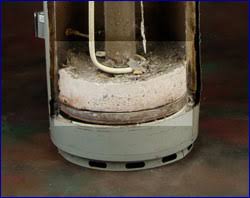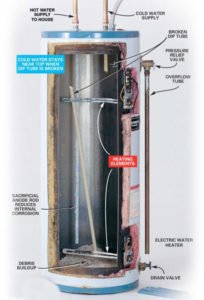FAQS
How Do You Get Water in the Toilet Tank to Stop Overflowing?
The fill valve in the tank has a leak in it. Also, if the fill valve has been replaced recently it is possible that it is on too high of a setting. If the fill valve is old, there’s no harm in replacing it. Sometimes the shaft or wire that is used to set the level has completely corroded, but replacing it should fix your problem.
What is that White Substance that Builds-Up on my Showerhead and What Can I Do About It?
No need to worry, the white substance is actually deposited minerals, common in both municipal and well systems. To remove the mineral deposits from the showerhead, pour a cup of vinegar into a plastic bag and then place the bag over the showerhead fixture and leave it in place overnight. The next day, remove the bag and use an old toothbrush to scrub off the deposits.
What is the Best Solution for a Clogged Bathtub or Sink Drain?
This is a very common problem and there is no definitive answer as each drain could be clogged for a different reason. The best thing to do is make sure that the drain isn’t clogged with hair or soap chips. You can do this by visually inspecting the bathtub or sink drain. The best way to clean hair from a bathtub drain is to remove the drain grate and take a coat hanger and put a little hook on the end and scoop out the hair.
You could also use a pair of needle nose pliers as well. The easiest way to clean hair from a lavatory sink drain is to remove the pop-up drain assembly altogether and use the same technique as mentioned above.
How Do You Remove Mould From Front-Loading Washers?
It seems that this is basic maintenance that is required for these front-load Whirlpool® and Kenmore® washers. It is actually quite simple and should not take more than an hour from start to finish.
After disconnecting the washer from the electrical socket, remove the lower front panel by unscrewing the 3 “T-20 torx” screws. Place a large rag under the washer to soak up any excess water. Then remove the cap at the front of the washer to expose the pump filter. Clean these parts in bleach and reinstall them. Next, remove the detergent tray and clean with bleach, as well as the tray compartment.
Finally, wipe the gray door gasket on all 3 sides with a bleach-soaked rag. Once you are finished, run a wash with hot water and add bleach. This will kill all the mould and make your machine smell like new.
To prevent the reoccurrence of mold, some routine maintenance should be carried out every few months. It’s also a good idea to keep the door and detergent tray open in between washes in order to air out the pieces and prevent future mould formation.
Salt works fairly well at neutralizing mould spores; use approximately two cups of table salt in warm water and run a full cycle on low water. You will find that any mildewy smells will be removed. You can also try approximately two cups of bleach (without laundry), which is comparably effective in removing mould and any associated odours.
How Do You Prepare Your Outside Water Tap for Winter?
The best way to protect your outside water tap during freezing conditions is to locate the inside shutoff valve from the supply pipe to cut off water supply to the tap. Next, open your outdoor tap by rotating handle counter-clockwise. As the shutoff valve is inside the home, there is no need to insulate the pipe or tap.
How Do You Maintain Your Hot Water Tank?
Although it’s detailed in the manual, many homeowners skip over the maintenance suggestions and skip to the hot shower. We can’t blame you for wanting to enjoy a nice shower, though these simple tips can extend the enjoyment of your hot water heater for many years to come.
As water is constantly being heated within your tank, sediment and minerals tend to collect on the bottom. These deposits can reduce the effectiveness and lifespan of your hot water heater. Tanks with excessive mineral and sediment build-up also take longer to heat up and use more energy than would be necessary under ideal conditions. That is why we recommend servicing your hot water heater on an annual basis in order to remove these deposits.
Removing Hot Water Tank Deposits
To remove sediments from your hot water tank, all that is required is a little time and a bucket. With your bucket placed under the hot water tank’s spigot, open the valve and let the water drain until it is no longer cloudy. We recommend dumping your bucket outdoors in a place where you do not intend to grow grass, flowers, or other vegetation, as it’s best not to reintroduce these deposits into your plumbing system.
Another great tip that you only need to do once is insulate your hot water heater. This can enhance your hot water heater’s efficiency by up to 45%!




